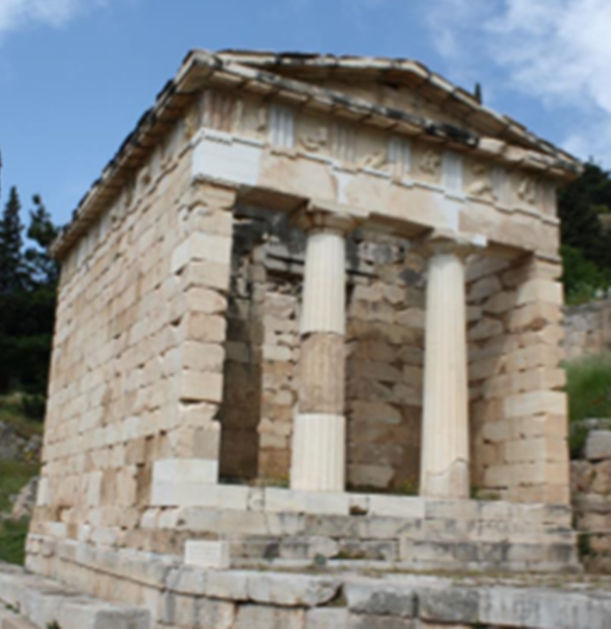Dedications: Delphi
The database entry below is a focus on the practices of dedicating at Delphi, and 3 case studies of specific dedications that not only made strong cultural connections between a polis and the fame of Delphi, but also projected a city's pride, power and place within the Greek world.
Archaeological Development
Once we have figured out an approximate dating of the monument on the site, we are able to get an idea of the trends in dedications from the 7th to 4th century BC. For example, the fifth century saw a start in the trend of dedicating to celebrate military victory. A famous example would be the Athenians dedciating their new treasury to Apollo to celebrate their dominant role in the victory at Marathon in 490 BC (as explained in further detail below). Another example is seen in where the Phocians dedicated "statues around the tripod - that is, on the temple terrace - and 2,000 shields from their victories over the Thessalians." [1]
Gods/Heroes
Delphi housed the Sanctuary of Apollo, hence every dedication was gifted to Apollo. The dominant hero presented in the decoration of the treasuries in this database is Heracles, due to his connection to Delphi. According to the myth, Heracles goes to the Delphic oracle and prays to Apollo for guidence, after Hera drove him to the point of insanity, killing his wife Megara, son and daughter. Heracles is then told to serve the king of Mycenae, Eurysthenes, for 12 years, and it is during these years where he must complete the 12 difficult labours. Once he does these labours, he is promised immortality.
Case Studies of 3 Treasuries at Delphi
The Sicyonian Treasury
Date: 560 BC.
This treasury could have possibly been erected to celebrate the ousting of the tyranny at Sicyon. This idea has emerged due to the use of all of the blocks from the tryanny's dedications (the tholos and monopteros) as its foundations (as opposed to the usual mix of stone and earth), which not ony meant that it was elevated (making it more visible to visitors), but also meant, ideologically, that Sicyon is distancing itself from its tyrannical past. [2]

The image above portays the Ship Argo with two kithara players on board; the player on the left is named as Orpheus. The Dioskouroi on horseback are at either side. The myth of the Argonauts is local to Sicyon, which is in the northern Pelopponese - hence, this is Sicyon displaying itself, and the pride of its city, on the panhellenic stage. In more detail, the imagery of the Dioskouroi (Castar and Pollux) is also significant: During the expedition of the Argonauts, Pollux took part in a boxing contest and defeated king Amycus of the Babryces. After returning from there, the Dioskouroi helped Jason and Peleus to destroy the city of Iolcus in revenge for the treachery of the king Pelias. Hence, this is a myth of power of thier geographical area and also of good triumphing over evil.
The Siphnian Treasury
Date: 525 BC.
This is one of the most elaborate treasuries recorded at Delphi. It includes the use of caryatids (statues of women used as columns to the treasury). Herodotus tells us that the people of Siphnus achieved great wealth after the discovery of gold and silver mines and used the majority of their newly-found fortunes on the treasury. [3]
The treasury of the Siphnians is situated in the “Sacred Way”, the processional route through Apollo’s sanctuary. It was placed on a higher ground level to that of the Sicyonian treasury, hence towered over it, especially to those approaching from the southeast of the sanctuary. [4]


The Athenian Treasury
Date (disputed): 510-480 BC.

This treasury, built of Parian marble, seems to have been erected around the time of the victory of Marathon, to celebrate the victory that Athens (according to them also) had a significant role in. [6] It was a this point where Athens became a prominent polis in the realm of dedicating at Delphi to celebrate military victory, linking to their self-presentation as an important military power in the Greek world.
The combination of Heracles (the Delphic hero) with Theseus (the Athenian hero) not only displays a partnership between Athens and Delphi, but also inserted Athens into the cultural landscape of the Delphic sanctuary. The layout of the friezes made visitors take a full route around the treasury. A new way of viewing and experiencing a sanctuary? [7] Accesibility along the western side of the santuary was improved due to the creation of a set of stairs linking the two terraces.

The politics of managing dedications at Delphi
Who used the site, and where did they come from?
Delphi as a panehellenic sanctuary: As Delphi was a panhellenic sanctuary, it was visited by numerous poleis in the Greek world who consulted the Pythia, and dedicated for either Apollo to do them a favour, or as a thanks for a favour being done. Not only this, by dedicating in a site where other cities visited, one could project their wealth and status to everyone who visited the sanctuary. For example, Athens was essentially thanking Apollo for their victory over the Persians, while simultaneously projecting their status and dominance within the site spacially and ideologically.
Select Site Bibliography
Herodotus, Histories, trans. R. Waterfield (OUP: Oxford 2008)
Scott, M (2010) Delphi and Olympia: the spatial politics of panhellenism in the archaic and classical periods. (Cambridge University Press: Cambridge)
Footnotes
1- Hdt.8.27.
2- Scott (2010) 62.
3- Hdt.3.57.
4- Scott (2010) 60.
5- Scott (2010) 66.
6- Scott (2010) 77.
7- Scott (2010) 81.
8- Scott (2010) 35-39.
Location


Site Plan

